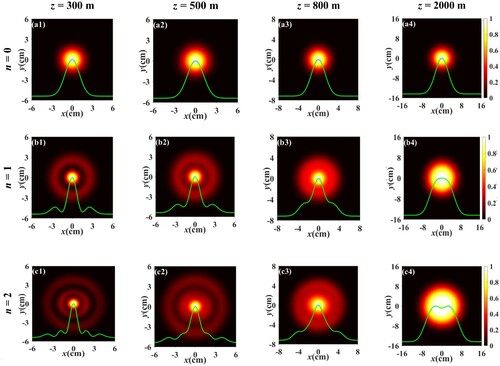 ?Mathematical formulae have been encoded as MathML and are displayed in this HTML version using MathJax in order to improve their display. Uncheck the box to turn MathJax off. This feature requires Javascript. Click on a formula to zoom.
?Mathematical formulae have been encoded as MathML and are displayed in this HTML version using MathJax in order to improve their display. Uncheck the box to turn MathJax off. This feature requires Javascript. Click on a formula to zoom.Abstract
Analytical formulas for average intensity of partially coherent twisted Laguerre-Gaussian beam (PCTLGB) propagating through anisotropic atmospheric turbulence are derived based on the extended Huygens–Fresnel principle. Our results indicate that PCTLGB gradually evolves from dark hollow distribution to flat-topped distribution and finally degenerates to Gaussian distribution both in free space and atmospheric turbulence. We also find that the effect of atmospheric turbulence on propagation characteristics for PCTLGB can be effectively reduced by adjusting twisted factor, topological charge and beam order. An important result is that PCTLGB has stronger anti-turbulence ability when vortex phase and twisted phase have the same chirality, and it can resist atmospheric turbulence more effectively than the beam without twisted phase under the same conditions. Our results will be useful in free space optical communication, lidar detection and imaging.
1. Introduction
The propagation characteristics of laser beams in atmospheric turbulence are of great significance in free-space optical communication (FSO) [Citation1], imaging [Citation2], remote sensing [Citation3] and radar systems [Citation4], and have attracted widespread attention in recent years. For example, Xu et al. [Citation5] have studied the propagation properties of the partially coherent Laguerre–Gaussian beam (PCLGB) through turbulent atmosphere, it shows that the PCLGB is less affected by the turbulent atmosphere than the fully coherent Laguerre–Gaussian beam. In addition, Cui et al. [Citation6] have found that the twisted Gaussian Schell-model beam is less affected than the Gaussian Schell-model beam without twisted phase modulation both in non-Kolmogorov turbulence and Kolmogorov turbulence. However, their studies simply focused on the isotropic atmospheric turbulence, subsequent experimental and theoretical studies have shown that atmospheric turbulence also exhibits anisotropic property [Citation7–13]. Furthermore, many types of research indicate that the inhomogeneity of the refractive index in the atmosphere leads to the random variation in the amplitude and phase of the laser beam, these fluctuations will cause the effects such as extra spreading beyond the pure diffraction, beam wander, intensity fluctuations and loss of spatial coherence [Citation10–14]. Studies have demonstrated that these phenomena can seriously affect the characteristics of the beam in practical applications. Therefore, reducing the effect of turbulence on beam transmission quality is necessary [Citation13,Citation14].
Due to the special properties of spiral wave-front structure and definite topological charge, vortex beam has shown an attractive application prospect in optical tweezers, particle manipulation, optical quantum calculation and information transmission. Different from the traditional coding method based on the polarization state of the beam, vortex beam adopts orbital angular momentum (OAM) as the information carrier, which can increase the information capacity of transmission and improve the confidentiality of communication [Citation15–17]. There are many kinds of vortex beams, among which Laguerre-Gaussian beam (LGB) is easy to be produced in experiments and has been widely studied [Citation18–30]. With the decrease of the degree of coherence, the speckle effect of partially coherent beam (PCB) is weakened and the light intensity is more evenly distributed [Citation22–24]. The twisted phase is a phase unique to PCB, which opens up a new study direction for the phase research of PCB [Citation25]. According to reports, PCB with twisted phase has great advantages in resisting beam drift and beam intensity scintillation caused by atmospheric turbulence [Citation26–29].
There are many kinds of beam structures, such as partially coherent structure, twisted phase structure, vortex phase structure mentioned above, which show excellent anti-turbulence ability respectively. However, it must be emphasized that the beam obtained by joint regulation of these beam structures may not show better transmission characteristics. Therefore, attention should be paid to the adjustment of parameters so as to obtain the beam with better propagation characteristics when the beam structures are regulated jointly [Citation15,Citation17,Citation28,Citation30]. To the best of our knowledge, to date, the propagation properties of partially coherent twisted Laguerre-Gaussian beam (PCTLGB) in anisotropic atmospheric turbulence have not been still investigated. In this paper, we first derive the transmission formulas of the average intensity for PCTLGB in anisotropic atmospheric turbulence, then the intensity distribution of the beam is simulated numerically, and the anti-turbulence ability of the beam is studied. Our results have a certain reference value for the research of FSO and other fields.
2. Theory
The formula for the electric field of the LGB in the source plane (z = 0) is given by [Citation5, Citation18, Citation21]
(1)
(1) where ρ’ is the radial coordinate and θ’ is the azimuthal coordinate,
(·) describes the Laguerre polynomial with mode orders m and n, m and n denote the topological charge and the beam order, respectively. ω0 is the waist width of the fundamental Gaussian mode. For m = n =µ = 0, Equation (1) degenerates to the electric field of the fundamental Gaussian beam; for n =µ = 0, m ≠ 0, Equation (1) degenerates to the electric field of the vortex beam.
The Laguerre-Gaussian mode can be described by the Hermite-Gaussian mode [Citation5, Citation21]
(2)
(2) where H2t+m−s(x’) and H2n−2t+s(y’) are the Hermite polynomials,
and
are the binomial coefficients. Substituting Equation (2) into Equation (1), the electric field of the LGB can be given by the following alternative form in Cartesian coordinates:
(3)
(3)
Then the LGB is extended to the partially coherent case. The second-order statistics of PCB can be characterized by the cross-spectral density (CSD) function [Citation7,Citation14]
(4)
(4) where x1’, y1’, x2’, y2’ represent the coordinates of any two points in the source plane, 〈·〉m denotes the ensemble average and ‘*’ describes the complex conjugate.
The CSD of PCLGB in the source plane can be expressed as [Citation5, Citation21]
(5)
(5) where
, for convenience, we set σxx = σyy = σ0, which denote the transverse coherence width. Based on Equation (5), we can obtain the CSD of PCTLGB in the source plane
(6)
(6) where µ is the twisted factor. The CSD of PCTLGB in atmospheric turbulence can be expressed as [Citation5, Citation18, Citation21]
(7)
(7) where k = 2π/λ is the wave number with λ being the wavelength, ρ1x, ρ1y, ρ2x, ρ2y are the coordinates of any two points in the receive plane. The turbulent factor 〈exp [ψ1 + ψ*2] 〉 can be expressed as [Citation14]
(8)
(8) where ρd' = (x1’ – x2’, y1’ – y2’), ρd = (ρ1x − ρ2x, ρ1y − ρ2y), and ρ0 is the spatial coherence length of spherical wave propagation in the turbulence, which has the form as [Citation14]
(9)
(9) where Φn is the power spectrum. In this paper, we only study the propagation of beam in the horizontal direction. The form of the anisotropic atmospheric turbulence spectrum is expressed as [Citation7–14]
(10)
(10)
where α denotes the generalized exponent parameter, C2n is the generalized refractive structure constant with units m3–α. ξ denotes the anisotropic factor which is used to parameterize the asymmetric distribution of turbulence cells. κx2+κy2+κz2 = κ2, κx2+κy2 = κxy2 with κx, κy and κz are the components of κ in the x, y and z directions, respectively. κm = c(α)/l0 and κ0 = 2π/L0 with L0 and l0 being the outer and inner scales of turbulence, respectively, A(α) and c(α) are given by [Citation7–14]
(11)
(11) with Γ(·) is the Gamma function. When α = 11/3, ξ = 1, Equation (10) reduces to the von Karman spectrum.
Substituting Equation (10) into Equation (9), ρ0 can be given by
(12)
(12) where Γ'(·, ·) denotes the incomplete Gamma function.
Substituting Equation (6) and Equations (8)–(12) into Equation (7), after the tedious integral, we can obtain
(13)
(13) with
(14)
(14)
In above derivations, we have used the following formulas [Citation17]:
(15)
(15)
(16)
(16)
(17)
(17)
(18)
(18)
The average intensity of PCTLGB in the receive plane can be obtained by setting ρ1x = ρ2x = x and ρ1y = ρ2y = y in Equation (13)
(19)
(19)
Applying the above-derived formulas, the average intensity of PCTLGB propagating through anisotropic atmospheric turbulence can be directly investigated.
3. Numerical calculations
Now we study the numerical results of average intensity for PCTLGB in free space and atmospheric turbulence under different beam parameters and turbulence parameters. The study parameters are set as λ = 632.8 nm, σ0 = 10 mm, ω0 = 20 mm, α = 3.4, L0 = 10 m, l0 = 10 mm, ξ = 5, these values will be used as calculation parameters unless otherwise stated.
Figure studies the effect of atmospheric turbulence on average intensity for PCTLGB. It shows that PCTLGB gradually evolves from hollow distribution to flat-topped distribution in free space and atmospheric turbulence, and finally degrades to Gaussian distribution. This degradation is caused by the nature of atmospheric turbulence. The irregular random movement of the atmosphere, the random fluctuation of physical properties such as pressure, velocity and temperature at each point is usually called atmospheric turbulence, it leads to the random fluctuation of atmospheric refractive index and the irregular fluctuation of amplitude and phase when the beam propagates in turbulence, which are the main factors affecting the propagation characteristics of the beam [Citation5,Citation21,Citation29,Citation30]. When C2n = 0, PCTLGB propagates in free space (Figure a), and the beam still degrades, but the degradation is slower. However, in atmospheric turbulence (Figure b and c), the effect of turbulence on PCTLGB is more and more significant with the increase of C2n, and the beam degradation is accelerated. This implies that the stronger the turbulence is, the faster the beam degenerates, which is caused by the fact that turbulence reduces the coherence of the beam. By comparing Figure (c) with (d), it can be found that the degradation of PCTLGB is suppressed as α increases within the range of possible values, in other words, the atmospheric turbulence with larger α has less effect on PCTLGB. Figure (e) studies the propagation of PCTLGB in isotropic atmospheric turbulence, in comparison with Figure (d), we can find that anisotropic atmospheric turbulence has a weaker effect on PCTLGB than isotropic atmospheric turbulence.
Figure 1. The normalized average intensity distribution of PCTLGB with different C2n in anisotropic atmospheric turbulence. Calculation parameters: m = 1, n = 0, µ = −4×10−4 m−1, (a)–(c) α = 3.4, ξ = 5,(d) α = 11/3, ξ = 5, (e) α = 11/3, ξ = 1.
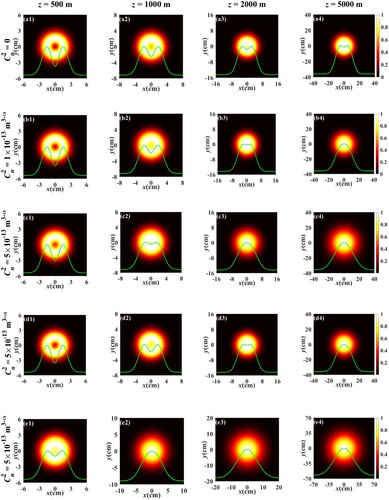
Figure shows the average intensity distribution of PCTLGB in anisotropic atmospheric turbulence. PCTLGB degenerates to PCLGB when µ = 0, it can be found from Figure (b) that PCLGB gradually degenerates from dark hollow distribution to Gaussian distribution with the increase of transmission distance, this time the vortex phase dominates the beam degradation. If the twisted factor is positive, the beam degradation from dark hollow profile to Gaussian profile can be accelerated; if the twisted factor is negative, the degradation slows down. This indicates that the beam degradation can be controlled by adjusting the signs of twisted factor and topological charge jointly, and the anti-turbulence ability of PCTLGB is stronger when the two signs are opposite, otherwise, the anti-turbulence ability is weaker. We think that this phenomenon is related to the chirality of twisted phase and vortex phase, when the chirality is the same, the OAM of vortex phase is enhanced by twisted phase, and the total OAM increases, then PCTLGB has a stronger ability to maintain the dark hollow shape in the propagation; when the chirality is opposite, the OAM of vortex phase is offset by twisted phase, and the total OAM decreases, so the ability of PCTLGB to maintain the dark hollow shape is weakened [Citation17,Citation25,Citation28].
Figure 2. The normalized average intensity distribution of PCTLGB with different µ in anisotropic atmospheric turbulence. Calculation parameters: C2n= 1×10−14 m3–α, m = 1, n = 0.
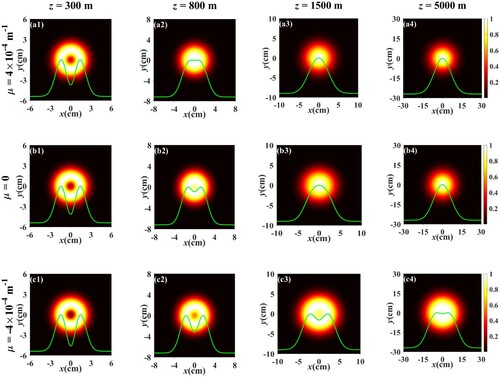
Figure further studies the effect of twisted factor µ on average intensity for PCTLGB. By comparing Figure (a1) with (a2)–(a4), we can find that PCTLGB degenerates faster than PCLGB when m and µ symbols are the same, which indicates that the former is more affected by turbulence and its ability to resist turbulence is weaker. On the contrary, Figure (b) shows that the beam degradation is suppressed when m and µ symbols are opposite, which means that PCTLGB effectively resists the effect of turbulence. In addition, it can be seen from Figure (b) that PCTLGB has stronger ability to maintain dark hollow shape as |µ| increases, it also suggests that the anti-turbulence ability of PCTLGB is stronger with the increase of |µ|.
Figure 3. The normalized average intensity distribution of PCTLGB with different µ in anisotropic atmospheric turbulence. Calculation parameters: C2n= 1×10−14 m3−α, m = 1, n = 0, z = 1000 m.
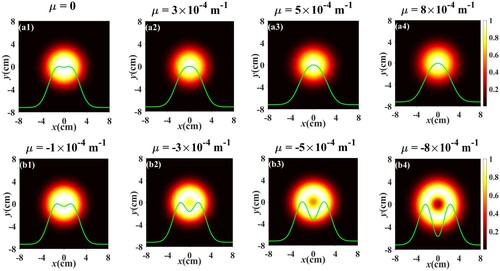
In Figure , we control the topological charge and twisted factor jointly to study its effect on the average intensity of PCTLGB. When m = n = 0, PCTLGB degenerates to partially coherent twisted beam (PCTB). It can be seen from Figure (a) that the average intensity distribution of PCTB is the standard Gaussian distribution. Figure (b) and (c) study the average intensity distribution of PCTLGB, and we found that PCTLGB has a stronger anti-turbulence ability than PCTB. By comparing Figure (b) with (c), it can be found that the larger m is, the stronger the ability of PCTLGB to maintain dark hollow shape is, and the stronger the anti-turbulence ability is. In addition, Figure also shows that the beam degradation will be accelerated when twisted factor is positive; when the twisted factor is negative, the process will be suppressed. This is the same as the case of m = 1. In summary, PCTLGB has stronger anti-turbulence ability when topological charge is larger and the chirality of vortex phase is the same as twisted phase (opposite signs).
Figure 4. The normalized average intensity distribution of PCTLGB with different m and µ in anisotropic atmospheric turbulence. Calculation parameters: C2n= 1×10−14 m3−α, n = 0, z = 1500 m.
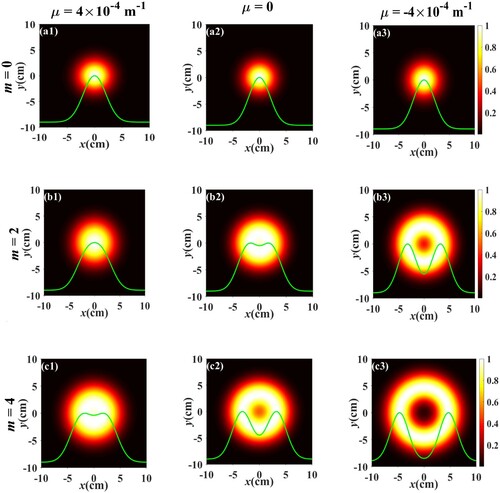
Figure studies the effect of beam order n on the average intensity for PCTLGB. It shows that dark rings appear as n increases, and n determines the number of dark rings. In addition, it can be found that PCTLGB gradually degenerates from ring shape to Gaussian shape when PCTLGB propagates in atmospheric turbulence, and the larger the beam order, the slower the beam degradation, which indicates that the anti-turbulence ability enhances with the increase of beam order.
4. Conclusion
We have explored the average intensity of PCTLGB propagating through anisotropic atmospheric turbulence. The effects of generalized refractive structure constant C2n, twisted factor µ, topological charge m and beam order n on the average intensity for PCTLGB are numerically analysed. It can be found that PCTLGB gradually evolves from hollow distribution to flat-topped distribution and finally degenerates to Gaussian distribution both in free space and atmospheric turbulence. Numerical simulation results show that the effect of anisotropic atmospheric turbulence on PCTLGB is lager with the increase of C2n, and the larger n is, the more effective PCTLGB can resist the effect of turbulence. Most importantly, we find that jointly controlling vortex phase and twisted phase have the same chirality (opposite signs) and the larger m, n, |µ|, the stronger ability of PCTLGB to resist turbulence, and at this time, the anti-turbulence ability of PCTLGB is significantly stronger than that of PCLGB and PCTB. In comparison with PCLGB, PCTLGB exhibits better characteristics in FSO, lidar detection and imaging, etc.
Disclosure statement
No potential conflict of interest was reported by the author(s).
Additional information
Funding
References
- Hu ZM, Jiang DG, Liu X, et al. Performance research on flat-topped beam-based small satellites free space optical communication. Opt Commun. 2021;487:126802.
- Tong ZS, Cai YJ, Korotkova O. Ghost imaging with electromagnetic stochastic beams. Opt Commun. 2010;283(20):3838–3845.
- Wang JF, Chen ZT, Hu XY, et al. Research on method of high-precision 3D scene optical remote sensing imaging simulation. J Mod Opt. 2019;66(19):1859–1870.
- Huang J, Wang DY, Xia SZ. An optimal beam alignment method for large-scale distributed space surveillance radar system. Adv Space Res. 2018;61(11):2777–2786.
- Xu YG, Li YD, Zhao XL. Intensity and effective beam width of partially coherent Laguerre–Gaussian beams through a turbulent atmosphere. Opt Soc Am A. 2015;32(9):1623–1630.
- Cui Y, Wang F, Cai YJ. Propagation of a twist Gaussian–Schell model beam in non-Kolmogorov turbulence. Opt Commun. 2014;324:108–113.
- Zhao L, Xu YG, Yang SK. Statistical properties of partially coherent vector beams propagating through anisotropic atmospheric turbulence. Optik (Stuttg). 2021;227:166115.
- Ata Y, Baykal Y. Field correlation of flat-topped beams in anisotropic non-Kolmogorov turbulent atmosphere. J Mod Opt. 2019;66(2):130–135.
- Zhu Y, Zhang YX, Yang GF. Evolution of orbital angular momentum mode of the autofocusing hypergeometric-Gaussian beams through moderate-to-strong anisotropic non-Kolmogorov turbulence. Opt Commun. 2017;405:66–72.
- Zhai C. Fiber-coupling efficiency of a Gaussian-beam in anisotropic non-Kolmogorov turbulence in the presence of random angular jitter. Results Phys. 2020;16:102985.
- Cui LY. Effects of anisotropic turbulence on the long term beam spread and beam wander of Gaussian beam. Optik (Stuttg). 2018;163:152–158.
- Cui LY, Cao L. Angle of arrival fluctuations of optical waves considering finite turbulence outer scale under anisotropic turbulence. Optik (Stuttg). 2016;127(8):3820–3827.
- Ata Y, Baykal Y, Gokce MC. Average channel capacity in anisotropic atmospheric non-Kolmogorov turbulent medium. Opt Commun. 2019;451:129–135.
- Cheng MJ, Guo LX, Li JT, et al. Average intensity and spreading of a radially polarized multi-Gaussian Schell-model beam in anisotropic turbulence. J Quant Spectrosc Radiat Transfer. 2018;218:12–20.
- Yang YJ, Zhao Q, Liu LL, et al. Manipulation of orbital-angular-momentum spectrum using pinhole plates. Phys. Rev. Appl. 2019;12(6):064007.
- Guo X, Yang C, Duan ML, et al. Propagation of partially coherent vortex beams in gain media. Optik (Stuttg). 2021;243:167361.
- Liu YL, Lin R, Wang F, et al. Propagation properties of Laguerre-Gaussian Schell-model beams with a twist phase. J Quant Spectrosc Radiat Transfer. 2021;264:107556.
- Xu YG, Tian HH, Feng H, et al. Propagation factors of standard and elegant Laguerre Gaussian beams in non-Kolmogorov turbulence. Optik (Stuttg). 2016;127(22):10999–11008.
- Gao YR, Gao XY, Lin R, et al. Periodic properties of Laguerre-Gaussian correlated Schell-model beams in a gradient-index fiber. Optik (Stuttg). 2021;228:165755.
- Jin X, Zhang H, Xu YC, et al. Representation and focusing properties of higher-order radially polarized Laguerre-Gaussian beams. J. Mod. Opt. 2015;62(8):626–632.
- Wang F, Cai YJ, Korotkova O. Partially coherent standard and elegant Laguerre-Gaussian beams of all orders. Opt Express. 2009;17(25):22366–22379.
- Zhang YT, Ding CL, Pan LZ, et al. Laser arrays of partially coherent beams with multi-Gaussian correlation function. J Quant Spectrosc Radiat Transfer. 2018;218:1–11.
- Liu XL, Liu LX, Peng XF, et al. Partially coherent vortex beam with periodical coherence properties. J Quant Spectrosc Radiat Transfer. 2019;222:138–144.
- Zhao XC, Zhang L, Lin R, et al. Hermite non-uniformly correlated array beams and its propagation properties. Chin Phys Lett. 2020;37(12):124202.
- Zhang B, Huang HK, Xie CX, et al. Twisted rectangular Laguerre-Gaussian correlated sources in anisotropic turbulent atmosphere. Opt Commun. 2020;459:125004.
- Zhang LN, Cai YJ. Evolution properties of a twisted Gaussian Schell-model beam in a uniaxial crystal. J Mod Opt. 2011;58(14):1224–1232.
- Liu L, Peng XF, Chen YH, et al. Statistical properties of a radially polarized twisted Gaussian Schell-model beam in a uniaxial crystal. J Mod Opt. 2017;64(7):698–708.
- Peng XF, Wang HY, Liu L, et al. Self-reconstruction of twisted Laguerre-Gaussian Schell-model beams partially blocked by an opaque obstacle. Opt Express. 2020;28(21):31510–31523.
- Wang F, Yu JY, Liu XL, et al. Research progress of partially coherent beams propagation in turbulent atmosphere. Acta Phys Sin. 2018;67(18):184203.
- Zhao L, Xu YG, Dan YQ. Evolution properties of partially coherent radially polarized Laguerre-Gaussian vortex beams in an anisotropic turbulent atmosphere. Opt Express. 2021;29(22):34986–35002.

